Emboss 2-Rail Sweep Example 1
Introduction
This tutorial explains the Emboss 2-Rail Sweep. The main focus is using multiple cross sections successfully to achieve a desired result. Links are provided to the help topics that explain the transition types and cross section spacing options. Please complete this tutorial along with the other 2-Rail Sweep tutorials to gain a full understanding of the Emboss 2-Rail Sweep. All dialog parameters and BobART tree items are described in the Emboss 2-Rail Sweep help topic.
Example
Part 1) Open the Example File
-
In the Quick Access Toolbar, click
 Open.
Open.
The Open dialog is displayed. -
Navigate to: C:\BobCAD-CAM Data\BobCAD-CAM V**\Examples\BobART\BobART Files.
-
Select Leaf.bbcd, and click Open.
Part 2) Insert the Feature and Define the Stock
-
In the BobART tree, right-click
 Emboss Model, and click Emboss 2-Rail Sweep.
Emboss Model, and click Emboss 2-Rail Sweep.
Because the stock is not defined, the Stock Parameters dialog is displayed so you can set the stock parameters.
(To modify the stock after it is created, right-click Emboss
Model, and click Create/Modify
Stock.)
Emboss
Model, and click Create/Modify
Stock.) -
In the Stock Parameters dialog, leave the Origin values set to X0Y0Z0.
In the Model Size group, set the X value to 8.00, and set the Y value to 5.50.
Click OK.
The 2 Rail Sweep dialog appears. -
Click Color to open the Color dialog.
-
Select a dark green color, and click OK.
-
Click OK again to accept the change and close the 2 Rail Sweep dialog.
The stock is drawn in the graphics area and the ![]() 2-Rail Sweep 1-Add item is added to the BobART tree.
2-Rail Sweep 1-Add item is added to the BobART tree.
Part 3) Define Geometry for Rail 1 and Rail 2
-
Right-click
 Rail 1-Geometry,andclick
Re/Select.
Rail 1-Geometry,andclick
Re/Select. -
Select the upper geometry, as shown next.
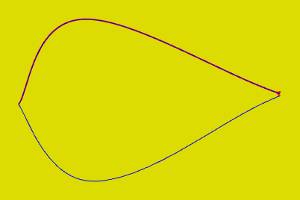
To confirm the selection, right-click anywhere in
the graphics area, and click ![]() OK.
OK.
A zoomed in view of the chain direction arrow is shown next.
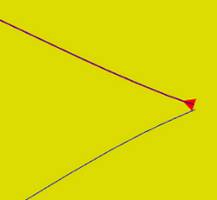
The geometry and chain direction for Rail
1 is now defined.
-
Right-click
 Rail 2 Geometry, and click Re/Select.
Rail 2 Geometry, and click Re/Select. -
This time, select the lower geometry.
The result should look like the image shown next.
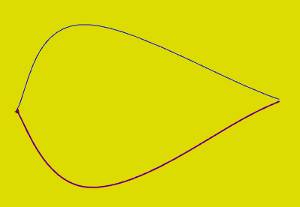
To confirm the selection, click ![]() OK.
OK.
A zoomed in view of the chain direction arrow is shown next.
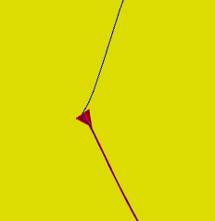
The geometry and chain direction for Rail 2 is now defined.
Make sure that chain direction of each rail is the same as shown in the previous images.
Tip: To reverse the direction of the chain, right-click Rail Geometry, and click Reverse Direction. The selected chain and direction are shown by clicking Rail-Geometry in the BobART tree.
Part 4) Add Cross Sections and Define the Cross Section Geometry
-
Right-click
 Cross-Section
Geometry-1, and click Re/Select.
Cross-Section
Geometry-1, and click Re/Select.
The lowest of the three entities located outside the stock area is the first cross section used. -
Hold down Shift, and click the far-right end of the entity so that the entire chain is selected.
Click OK.
OK.
The geometry and chain direction for Cross-Section 1 is now defined and should appear as shown next.
-
Right-click Cross-Section Geometry-1, and click Add New Cross Section Geometry.
-
Repeat Step 3 so there are three Cross Section Geometry items in the BobART tree.
-
The middle entity is the second cross section used.
Right-click Cross-Section Geometry-2, and click Re/Select.
Press and hold Shift, and click the right side of the entity.
Click ![]() OK.
OK.
The geometry and chain direction for Cross-Section 2 is now defined and should appear as shown next.
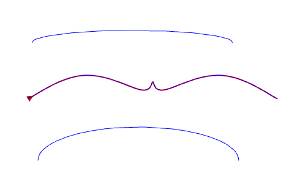
-
Repeat this process for the Cross-Section Geometry 3 so the result looks like the following.
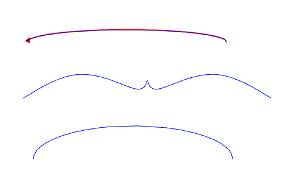
The direction of the selected cross-section geometry is important because the start point of the cross section is connected to Rail 1 and the end is connected to Rail 2. The cross section is swept along the rails from the starting point to the opposite end. The outcome of any 2-rail sweep is controlled entirely by the chain direction used for each entity.
Tip: To reverse the chain direction, right-click Cross Section Geometry, click Reverse Direction. The selected chain and direction are shown by clicking Cross-Section Geometry in the BobART tree.
All entities are now defined for the 2 rails and the 3 cross sections for this sweep. The next step is to generate the sweep.
Part 5) Generate the Emboss 2-Rail Sweep, Edit Features, and Regenerate
-
Right-click
 Emboss Model, and click Regenerate.
Emboss Model, and click Regenerate.
The embossed leaf is created and should appear like the next image.
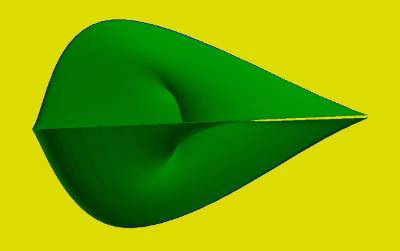
Notice that this is not the desired result.
The problem here is that the 2 rails do not share
the same chain direction.
-
Click in the graphics area, and press E to hide the emboss.
In the BobART tree, click Rail 1-Geometry to see the chain direction.

-
This chain direction is not desired.
Right-click Rail 1-Geometry and click Reverse Direction.
The chain direction is now from left to right as shown next.
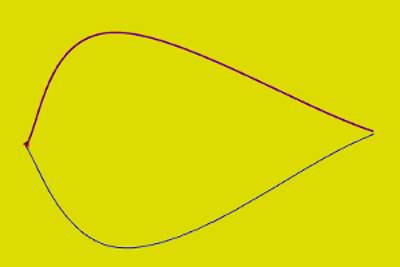
-
Right-click
 Emboss Model,
and click Blank/Unblank to
show the model.
Emboss Model,
and click Blank/Unblank to
show the model. -
Right-click
 Emboss Model,
and click Regenerate.
Emboss Model,
and click Regenerate.
The embossed model should now appear as shown next.

Tip: Every time that you change a 2-Rail
Sweep parameter, right-click ![]() Emboss Model, and click Regenerate to
see the changes reflected in the model.
Emboss Model, and click Regenerate to
see the changes reflected in the model.
The model shown from the side view.

The elevation, or height, of the previous image is a result of using Scale Cross Section Based on Width. When this option is used, the entire cross section (width and height) is scaled to fit between the rails. When the check box is cleared, only the cross section width is scaled and the height remains the same. This means that the sweep height is controlled by the actual height of the cross section geometry. This is shown next.
-
Right-click
 2 Rail Sweep 1 - Add, and
click Edit.
2 Rail Sweep 1 - Add, and
click Edit.
Click to clear the ![]() Scale
Cross Section Based on Width check box, and click OK.
Scale
Cross Section Based on Width check box, and click OK.
Right-click ![]() Emboss
Model, and click Regenerate.
Emboss
Model, and click Regenerate.
The sweep should appear as shown next.
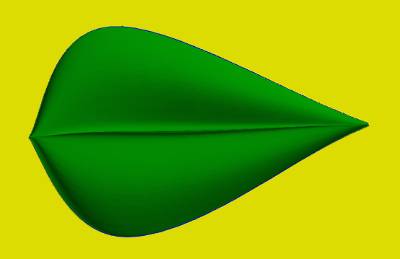
The model shown from the side view.

Notice in the previous image, the height changes along the sweep. The height on the left side is the same as the height of the first cross section. The height on the right side is the same as the height of the last cross section. The same is true for the middle, with the height in between cross sections blended together.
When using three or more cross sections, the way that they are blended together is defined by the Transition Type. Find out more about the Cross Section Spacing options in the Emboss 2 Rail Sweep topic.
The cross sections can be modified further using the Cross Section Spacing options. Find out more about the Cross Section Spacing options in the Emboss 2 Rail Sweep topic.
This concludes the tutorial.
